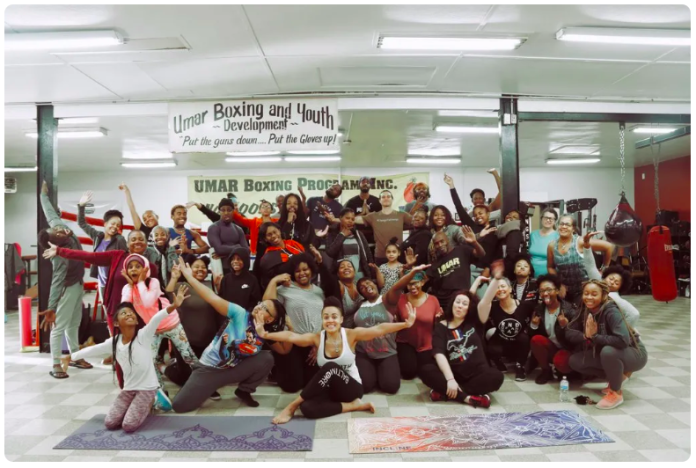
There is no denying the growing popularity of yoga. With more than 300 million participants worldwide, its integration of mind, body, and soul has created its unique lane in the fitness sector. The benefits of yoga are long documented and widely known, and in an era focused on mental health and wellness, this boom isn’t going to slow down anytime soon.
In a 2016 study by the Yoga Journal and Yoga Alliance, 36 million Americans rolled out their yoga mats, up from 20.4 million participants in 2012. But as more yoga studios fill up nationwide, there is still a noticeable absence of participation in the BIPOC– or Black, Indigenous People of Color– community.
“Most of the students I teach in my classes are White,” said Michelle Stafford, owner of DivaYogi in Baltimore. “The first yoga class I went to, I was the only Black student there.”
Stafford credits this disparity to a lack of representation, accessibility, and cost.
Black yogi enthusiasts say accessibility and cost are the key factors in the scant representation of Black faces.
Although yoga originated in Northern India more than 5,000 years ago, 84 percent of yoga participants in the U.S. are White. Carson Williams, a Black resident of Silver Spring, Md., stopped attending yoga classes soon after joining one at her local gym.

“I started doing yoga at home watching YouTube during the pandemic,” Williams said. “When the pandemic lifted, I was excited to attend in-person classes, but I just didn’t fit in. Everyone was nice, but I was the only Black person there. The energy was just too thick for me.”
Yoga is a powerful tool that can aid in the healing of systemic trauma, chronic stress, and anxiety in a community that has suffered for generations. A safe yoga space can provide a path to physical strength and emotional healing, says Stafford, who is credited with founding the BeMore Yoga community.
“Yoga is more than just poses,” she said. “This is life-saving stuff.”
“There are a lot of people who have trauma and don’t even know. As Black people in America, we are “on” all the time,” Stafford added. “That is a level of stress that we wear all the time. Where do you have space to let that wall down?”
Black-owned yoga studios can provide a safe space for vulnerable communities often associated with the BIPOC community. Instructors from the same community can effectively draw out these connections that are often missed in studios that lack diversity.
Instructors that are hoping to get into the industry, however, must clear the financial hurdles of finding studio space, bringing in clientele and the accreditation process itself. Certifications to become a yoga instructor can cost thousands of dollars, effectively pricing out most instructors.
Since the pandemic, more Black instructors are taking to platforms like YouTube and Instagram to share their practices and showcase their work. This has sparked a rise in participation among Black men, women and childrens, according to Stafford.
Hip Hop Yoga, Trap Yoga, Twerk Yoga, Men’s Yoga, African Yoga, and Christian Yoga are niche classes created by Black instructors in an effort to appeal to the diverse interests of Black and Brown people. Stafford, who teaches Iyengar Yoga in both affluent and underserved communities, recognizes the benefit of reaching new participants where they are.
“Most yoga studios are located in affluent White neighborhoods, and drop-in rates can cost up to $25,” she said, adding that this cost is for one person per class, which can be cost-prohibitive for the average family.
Her organization, BeMore Yoga Community, was created in 2008, thanks to a grant from Lululemon. It enabled her to address this underserved population bridging the gap between doing what she loves and with people she passionately cares about.
“I won’t refuse someone who can not afford to take one of my classes,” she said. “We’ll figure it out.”
In the past few years, Black adults’ participation has shifted in a positive direction, increasing from 2.5 percent to 5.6 percent in 2012, according to a 2015 National Statistics report. Thanks in part to platforms like The Black Yoga Teachers Alliance. Founded in 2009 by yoga teachers Maya Breuer and Jana Long, their objective is simple: bring more diversity to those who teach and practice yoga and to provide more opportunities to Black yoga teachers. The Black Yoga Teachers Alliance provides events, leadership and community to those seeking inclusion.
The celebration of yoga in the community of color has a rich history from the past.
Eartha Kitt, Rosa Parks, Angela Davis Alice and John Coltrane were all early adopters and avid students. Challenging these barriers will give rise to a new era of instructors that can provide needed refuge to a community open to change and mental wellness. You can follow DivaYogi via instagram,facebook, twitter or visit www.thedivayogi.com for more information.



